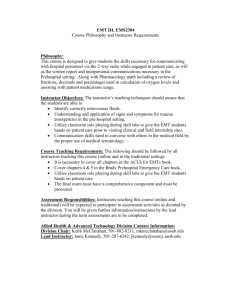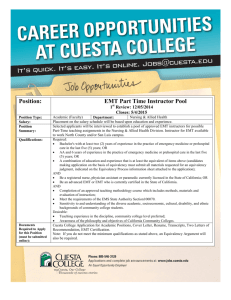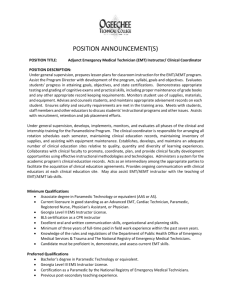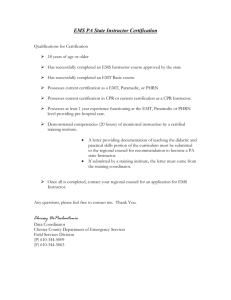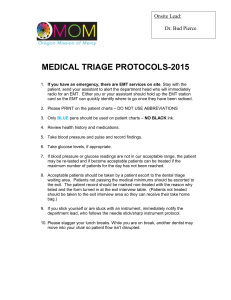EMT Class Policy Manual - 7/1/2013 - Battlefield Fire Protection District
advertisement
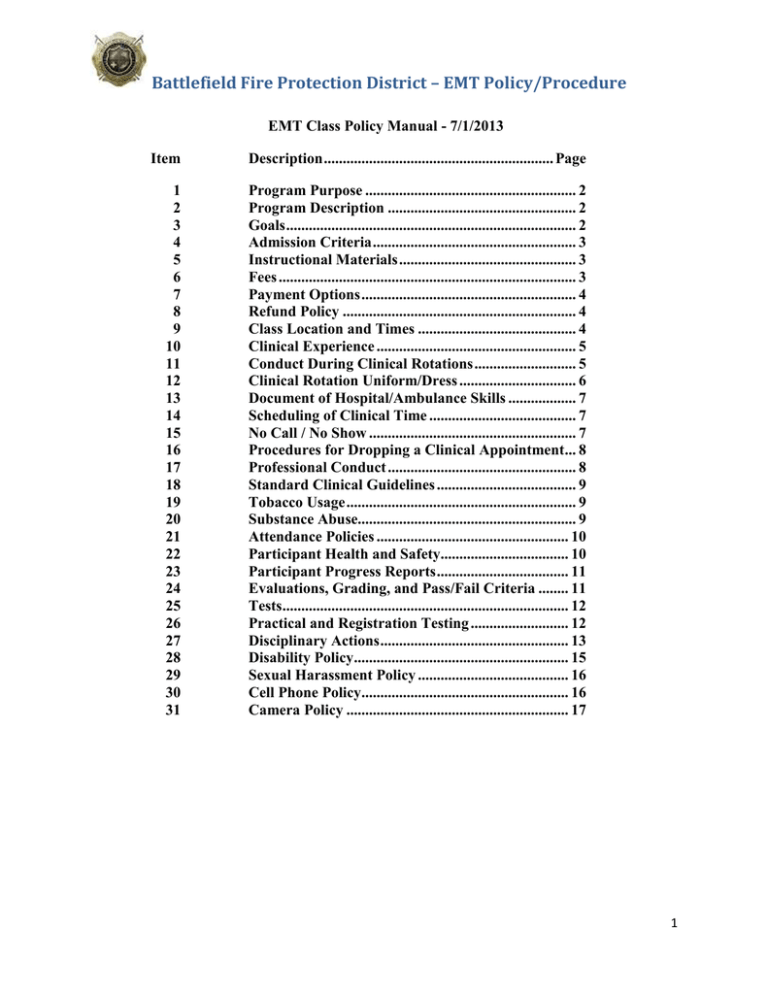
Battlefield Fire Protection District – EMT Policy/Procedure EMT Class Policy Manual - 7/1/2013 Item Description ............................................................. Page 1 2 3 4 5 6 7 8 9 10 11 12 13 14 15 16 17 18 19 20 21 22 23 24 25 26 27 28 29 30 31 Program Purpose ........................................................ 2 Program Description .................................................. 2 Goals ............................................................................. 2 Admission Criteria ...................................................... 3 Instructional Materials ............................................... 3 Fees ............................................................................... 3 Payment Options ......................................................... 4 Refund Policy .............................................................. 4 Class Location and Times .......................................... 4 Clinical Experience ..................................................... 5 Conduct During Clinical Rotations ........................... 5 Clinical Rotation Uniform/Dress ............................... 6 Document of Hospital/Ambulance Skills .................. 7 Scheduling of Clinical Time ....................................... 7 No Call / No Show ....................................................... 7 Procedures for Dropping a Clinical Appointment ... 8 Professional Conduct .................................................. 8 Standard Clinical Guidelines ..................................... 9 Tobacco Usage ............................................................. 9 Substance Abuse.......................................................... 9 Attendance Policies ................................................... 10 Participant Health and Safety.................................. 10 Participant Progress Reports ................................... 11 Evaluations, Grading, and Pass/Fail Criteria ........ 11 Tests............................................................................ 12 Practical and Registration Testing .......................... 12 Disciplinary Actions .................................................. 13 Disability Policy ......................................................... 15 Sexual Harassment Policy ........................................ 16 Cell Phone Policy....................................................... 16 Camera Policy ........................................................... 17 1 Battlefield Fire Protection District – EMT Policy/Procedure 1. PROGRAM PURPOSE This program was developed and implemented by the Battlefield Fire Protection District after recognizing the need for an accredited EMT course that provides a high quality education while maintaining a cost that is reasonable and affordable. It has been designed for individuals that are interested in providing care to patients in a pre-hospital setting. It will provide the participant an opportunity to gain broad based knowledge as it pertains to emergency care in both the didactic and practical curriculums in order to become certified as an EMT in the state of Missouri, which includes certification by the National Registry of Emergency Medical Technicians. 2. PROGRAM DESCRIPTION This program has been approved by the Missouri Department of Health and Senior Services, Emergency Medical Services Unit. It addresses information and techniques currently considered to be the responsibility of the EMT, according to the current United States Department of Transportation Emergency Medical Technician National Standard Curriculum. This program consists of classroom instruction, practical skills training, Emergency Room clinical time, and time in field internship with a designated ambulance service. 3. GOALS The program will contain information and skill labs which will enable a properly motivated and capable participant to: Demonstrate a basic understanding of human anatomy and physiology. Perform a primary, secondary and ongoing physical patient assessment. Understand, recognize and provide appropriate basic level pre-hospital care for life threatening and non-life threatening emergencies. Provide basic airway management. Assess vitals signs, breathing, pulse, and responsiveness of patients. Demonstrate use of an AED on an unresponsive, apneic, and pulseless patient. Write a comprehensive, detailed patient report. Give a clear concise radio report. Demonstrate proper use of Personal Protective Equipment and understand the risk factors in pre-hospital care. Understand the rationale of personal safety, patient safety, care at the scene, and care throughout transport to a receiving medical facility. 2 Battlefield Fire Protection District – EMT Policy/Procedure 4. ADMISSION CRITERIA Admission requirements for this program include: Be at least 18 years of age by the end of class. Completion of high school or GED. Certificate must be supplied as proof. Submission of a complete written application. Verification of TB skin test, Hepatitis B shots, and Rubella (MMR) Vaccination. A valid Missouri Driver’s License A valid CPR Card (this will be done during the class) A signed Criminal Background Check form. All students must pass a criminal background check prior to acceptance in this course. No exclusionary factors may be present in order to be accepted in this program (any drug, assault or sexual offence convictions will disqualify the applicant) All applicants must be in good physical health, current medical conditions must be included on the application. No disabilities present which may impede your ability to provide prompt and efficient care to the sick and injured. 5. INSTRUCTIONAL MATERIALS Prehospital EMERGENCY CARE ninth edition by Mistovich and Karren from Brady is issued in the class. 6. FEES The tuition for this program is $550.00. This fee includes equipment costs, background check, student uniform shirt, liability insurance required by the course, student handbook, student ID, and handouts as required in the class. Practical Exam and National Registry written test fees are NOT included. You should figure an additional $140.00 ($70.00 for MEMSA/NIEMT and $70.00 for NREMT) for these tests. If you are unable to pass the initial exams, you should expect an additional charge. (These fees are subject to change without prior notification) 3 Battlefield Fire Protection District – EMT Policy/Procedure 7. PAYMENT OPTIONS Students are responsible for the timely payment of tuition, fees and other applicable charges. Students will not be considered officially enrolled until all financial obligations have been met. Acceptable payment arrangements: Cash payment of account in full, prior to the start of class. Approved third party payment (VA, Fire Department, and Employer). 8. REFUND POLICY Students are eligible for refunds if procedures are followed and the lead instructor has been notified. Failure to attend classes does not constitute withdrawal from the class. Prior to any refund the cost of the book, background check, uniform cost, or other expenses that have already been used will be deducted from the amount available. Refunds will be available less a 20% fee per class, after the 5th class refunds will no longer be available. 9. CLASS LOCATION AND TIMES All classes will be held at: Battlefield Fire Protection District 4117 W. Second Street Battlefield, Mo. 65619 The classes will be held on Tuesdays and Thursdays, plus 1 Saturday a month. Tuesday and Thursday classes will start at 18:00, please be on time and ready for class. Saturday class will start at 08:00. Classes are scheduled until 22:00 on Tuesday and Thursday and until 12:00 on Saturday; please do not ask if we are getting out early. Classes that are missed must be made up by reading the chapter(s) missed and a 1000 word essay written on the chapter. These must be turned in within 2 weeks after the class is missed. No make-up work will be accepted after the last class. Total class hours = Approximately 172 hours 4 Battlefield Fire Protection District – EMT Policy/Procedure 10. CLINICAL EXPERIENCE Battlefield Fire Protection District students will participate in both hospital and field clinical rotations. These clinical rotations are an integral part of the student’s learning experience. It is imperative the student understand the clinical requirements. Clinical schedules are demanding and require unwavering dedication and attendance to each and every clinical. Students will be given several opportunities to sign up for their clinical times during class. Please note that there are several other schools that compete for the same available times, so it is recommended that you sign up early and be sure you are at your location a few minutes early to ensure you do not miss part of the clinical time. ER Clinical time – Minimum of 24 hours Ambulance Clinical Time – Minimum of 48 hours and 12 patient contacts 11. CONDUCT DURING CLINICAL ROTATIONS The EMT student must realize the importance of maintaining professional and courteous conduct throughout the clinical rotations as well as the entirety of the program. Access to clinical sites for practice and instruction is a PRIVELEGE and NOT a right. If a student fails to follow the policies and procedures of Battlefield Fire Protection Districts EMT program and/or policies of the designated clinical site, swift and decisive actions will be taken by the Lead Instructor to correct any problems. These actions include, but are not limited to, termination from the program (if deemed appropriate). If for any reason, the preceptor instructs you to leave the clinical site, DO SO IMMEDIATELY. The student should not question the preceptor or other clinical site staff regarding the reason for being asked to leave. The student’s next action shall be to contact the lead instructor immediately and advise them of the situation. The instructor will then conduct an investigation and determine the reason the student was instructed to leave the site. If the reason is found to be due to deficiency or inappropriate behavior, the instructor will contact the student and corrective and/or disciplinary actions will be taken. EMT students should assist the clinical site during “down time” with activities not usually associated with typical EMT functions (i.e., stocking, cleaning rooms, making of beds/cots, etc.) The more involved the student is in all aspects of the clinical sites, the more accepted the student will be by the site staff. The student should not be sedentary while the staff completes their assigned tasks – there is always something to do. If all tasks have been completed, the intern should utilize their time efficiently to further their studies by reading appropriate texts. 5 Battlefield Fire Protection District – EMT Policy/Procedure In the past, a few students have witnessed what they deem as inappropriate behavior by on-duty medical personnel while on a clinical rotation. If this occurs and you feel compelled to report such an incident, you must follow the proper chain of command; i.e., contact your lead instructor first and it will be the discretion of the program coordinator whether to pursue an investigation or report the matter in question to the appropriate personnel. 12. CLINICAL ROTATION UNIFORM/DRESS Professional appearance is of utmost importance. The following parameters will be strictly enforced: Navy Blue EMS style pants or dress slacks without pleats. The Battlefield Fire issued White student shirt. Black leather shoes or boots (polished) and black socks – NO tennis shoes. Battlefield Fire name tag identifying you as an EMT student. Watch with a second hand (or equivalent). Coats should be black, blue, or HiVis. No patches or insignias on uniform other than name tag, except those on it when it was delivered to you. Excellent personal hygiene. Long hair must be secured in ponytail or put up. Unusual hair colors do not promote a professional image, and will not be permitted. No fake/false fingernails – fingernails should be trimmed to no longer than ¼” long. No earrings or visible piercings are allowed. Writing utensil. Tattoos must be covered. Hats may be worn if approved by the lead instructor; they must be clean and new looking, preferably without a logo. Students may carry stethoscope, trauma shears, and penlights, but are not required to. Students are required to use Body Substance Isolation on every patient contact. 6 Battlefield Fire Protection District – EMT Policy/Procedure 13. DOCUMENTATION OF HOSPITAL/AMBULANCE SKILLS Students are to record information on every patient they have contact with, due to HIPPA requirements, the information to be recorded is very generic and should not be able to identify the patient. Information that is required: Male/Female Patient Age Chief Complaint What contact you had with the patient. A verifying signature from the Medic, EMT, Nurse, or ER Technician. 14. SCHEDULING OF CLINICAL TIME ER time will be scheduled with the Lead Instructor. We are limited to 2 students at a time in the ER. Shifts are 7am to 3pm, 3pm to 11pm. Time scheduled must be approved before you go to ER to work. Ambulance ride time will be scheduled with the ambulance during class times; they will come by for scheduling once every week or every other week. You need to have your schedule and sign up when possible. Ride time on the ambulance is shared between 2 to 6 other classes and normally passed out on a first come basis. When you arrive at the location for your scheduled clinical times, be sure to check in and wait for their assignment. You must be on time and preferably 10-15 minutes early. If you are late on an ambulance ride you could miss your ride time if they get an early call. 15. NO CALL / NO SHOW In the event you do not show up for a clinical shift, and do not call your instructor beforehand, you must do the following: Inform your instructor within 12 hours of the missed shift Pay a $25 fine to Battlefield Fire (you cannot attend any other clinical time until this fee is paid) 7 Battlefield Fire Protection District – EMT Policy/Procedure 16. PROCEDURES FOR DROPPING A CLINICAL APPOINTMENT In the event that something unexpected should happen and you must drop a clinical time, you must follow the system below. Call the clinical site at least 2 hours (sooner if possible) before your assigned shift. Identify yourself as a Battlefield Fire EMT Student, give them the date and time you were scheduled and let them know you are unable to be there. Be sure you get the name of the person you talked to and note the time and date of the call. Inform your instructor within 12 hours that you did not make the shift and give them the information of who and when the site was nofified. Please remember when you cancel out of a scheduled clinical time, that time could have been utilized by someone else. The available shifts are limited and can be hard to get. 17. PROFESSIONAL CONDUCT Appropriate conduct is the hallmark of a professional. Course participants are expected to consistently exhibit courteous and professional behavior with patients, their families, classmates, instructors, and health care providers. Confidentiality is a critical element of professional care. Participants should only discuss patients, their symptoms, diagnosis, behavior, etc. with the personnel assigned to that patient. Questions regarding the patient and his/her care should be directed to the doctor, nurse, EMT, Paramedic, or ER Tech directly involved with the patient. Federal law, known as HIPPA (Health Insurance Portability and Accountability Act) clearly protects Private Health Information regarding the patients you may come into contact with. Consider what others may see or hear when dealing with patient care and be cautious to protect every patient’s right to privacy. 8 Battlefield Fire Protection District – EMT Policy/Procedure 18. STANDARD CLINICAL GUIDELINES A. Arrive 10 minutes early for your clinical. B. Introduce yourself to the staff, and they will assign you a preceptor. C. Be sure your Preceptor signs your paperwork to verify you were there and what you did. No Signature = No credit D. Be sure your clinical paperwork is clear and legible. E. You are to participate in all functions from checking the ambulance/rooms to assisting as requested with patient care. Don’t plan on being just an observer. 19. TOBACCO USAGE Tobacco usage of any type is prohibited on Battlefield Fire Protection District Property. Tobacco may be used during breaks at the designated area only. Be sure to police the area so future tobacco users will have this privilege also. Tobacco usage during clinicals is strictly prohibited. Hospital grounds and hospital property is required to be tobacco free at all times. Hospital rules state that if you arrive at the workplace with the smell of tobacco on your clothes you will be asked to go home shower, change clothes and then you may be allowed to return. 20. SUBSTANCE ABUSE Substance abuse is prohibited. Any student who engages in substance abuse during clinical rotations or on campus will be discharged from the program. Students who engage in substance abuse off campus and not during working/classroom hours may be discharged if their substance abuse does affect, or is likely to affect, their ability to perform their official duties and/or classroom objectives. 9 Battlefield Fire Protection District – EMT Policy/Procedure 21. ATTENDANCE POLICIES Due to the volume of materials and speed at which it will be presented, attendance is expected at all classes. Student can miss no more than 8 hours (2 classes). Missing more than 8 hours will result in termination from the class without a refund. There will be a sign in sheet for every class; it is the student’s responsibility to sign this sheet at the beginning of every class. If you don’t sign in you will be counted as absent. Classes that are missed must be made up by reading the chapter(s) missed and a 1000 word essay is written on the chapter. These must be turned in within 2 weeks after the missed class. No make-up work will be accepted after the last class. 22. PARTICIPANT HEALTH AND SAFETY Good mental and physical health is necessary for an individual to maintain the pace and physical demands of this field. Universal infection control measures will be observed and practiced at all times with all patients. Course participants will be required to produce documentation regarding immunizations. Participants are required to have a TB skin test, Hepatitis B Vaccine series (this can be passed by signing a form declining the series), and. This is to be done by your physician at your expense. If you already have had these you need to supply documentation to the lead instructor. Without this documentation you will not be allowed to participate in clinical rotations. Course participants may occasionally be exposed to communicable and other medical diseases. It is the student’s responsibility to take all necessary precautions against contracting and transmitting such diseases. If a course participant does come into contact with a known case, he/she must report this immediately to your preceptor and seek necessary medical treatment. He/she shall also contact the lead instructor immediately. Course participants will be responsible for all diagnostic and treatment costs; the same holds true for any injury sustained as a student in this program. Any participant who has a communicable disease (common cold, flu, hepatitis, herpes, HIV related illness or fever, etc.) should not participate in the practical skills stations or direct patient care in the clinical setting. These individuals are expected to attend class (if their condition permits) and observe others in the practice stations. Real patients in the hospital and ambulance, classmates or fellow health care providers should never be put at risk from course participants with an infectious disease. The participant will be expected to practice on his/her own time to maintain skill levels in keeping with class progress. 10 Battlefield Fire Protection District – EMT Policy/Procedure All participants will perform with due regard for personal safety as well as the safety of patients and others involved with patient care. At no time will the participant perform any act which he/she or the preceptor deems as unsafe or inappropriate. All manikins, airway adjuncts, etc. will be properly cleaned with disinfectant between participant uses. Due to the nature of training, it is imperative all participants maintain good personal hygiene at all times. A sink and disinfecting soap is located in the building’s bathroom and will be routinely used by participants working with patients and equipment. Any participant with a history of chronic health problems such as recent surgery, back injury, or pregnancy will be required to present a medical release from a physician. The instructor has the option at all times to request such a release at his or her discretion (and at no cost to Battlefield Fire Protection District). Each participant should be able to lift 100-150 lbs.; however, all participants will exercise prudent physical exertion in labs and on calls (i.e., cot lifting, patient movement). If a participant suffers an injury while functioning as an EMT student, he/she will immediately report the occurrence to the preceptor and will notify the lead instructor as soon as possible, who in turn will investigate the situation immediately. No participant is allowed to drive EMS vehicles at any time while functioning within the scope of this training program. Failure to comply with this rule will result in termination from the program. 23. PARTICIPANT PROGRESS REPORTS The instructor will provide the program participants with progress reports during the course of the program if requested by the student. The participant may request a conference as necessary. 24. EVAVUATIONS, GRADING AND PASS/FAIL CRITERIA Written evaluations are the most appropriate and effective method for assessing the participants’ progress in converting course content into practical knowledge. Practical evaluations provide feedback to both the instructor and the participant on the ability of the participant to perform specific tasks. Participants must obtain at least an 85% average on the test taken. The instructors try to cover as much of the material as possible, however it must be noted that covering all the material is not possible with the schedule of the class. Therefore the student must read the text before the 11 Battlefield Fire Protection District – EMT Policy/Procedure classes or they will have problems keeping up with the class. The classes are graded on an average basis, scores 85 or above are passing while any score 84 or below needs work. There are 10 skill sheets; a copy of each skill sheet will be included in your initial packet given out on the first day of class. During class you will be required to do a minimum of 2 practices on each skill, and a minimum of 2 tests on each of the skill sheets. 25. TESTS To keep students comfortable with the written test, there will be a written test for every chapter. These are designed to test the information presented by the instructor as well as information in the student text. Most tests will be delivered over the internet; you will be allowed 6 days to complete most tests. The last 2 test will have shorter time for completion. You will be given a second opportunity to take tests that are not passed with an 85%. The retake period will be a 3 day window to retake the test. Tests that are not taken in the time permitted will be recorded as a “0”. The MidTerm test will be online and you will have 6 days to get the test done. Those that do not get an 85% or higher will be allowed a 3 day retest period The FINAL test will be a written exam given in class. The overall minimum for your test must average an 85%. All of the chapter tests will account for 30% of your score, The Midterm will account for 30% of your score, and the FINAL will account for 40% of your score. Skills must all be passed on the class final to successfully pass the course. A student must complete the steps as listed (in order) on the sheets. We will practice and complete all of these skills during class. The final practical testing will be done by outside personnel. You will have a maximum of 2 attempts to pass each skill. 26. PRACTICAL AND REGISTRATION TESTING A. Prior to being eligible for the National Registry Certification and Missouri State EMT Licensure a student must first pass a practical testing by MEMSA. This test must be signed up for and paid for online by the student (MEMSA.ORG or NIEMT.COM). The practical testing must be passed prior to taking the NR-EMT testing. B. Secondary testing will have to be done with the National Registry of Emergency Medical Technicians (NREMT.ORG). The initial signup for this test must be completed prior to the final test of the class. The test fee does not have to be paid for until you are ready to take the test. There is an additional cost for this test, this fee is the student’s responsibility. 12 Battlefield Fire Protection District – EMT Policy/Procedure Tests are recommended to be done as soon as possible after the class. Past results have shown the longer you wait the harder the test is to pass. MEMSA supplies only 2 initial tests and 2 repeat tests in the Springfield area per year. NIEMT has 4 to 5 classes per year in Aurora. Should you want any other test times you will have to go to the test site outside of the Springfield area. A list of available times and locations are available on the MEMSA/NIEMT website. You have 2 years after the last day of class to take and pass both tests for licensure. However the test is only good for a 1 year period. If you pass the MEMSA test and do not take the NREMT test until 13 months later, you will have to retake the MEMSA test to be eligible for licensure. You are allowed a maximum of 3 attempts to pass each portion of the test (there is a fee for each attempt). If you do not pass after 3 attempts you must complete a refresher course to be eligible to test again. 27. DISCIPLINARY ACTIONS Any action which discredits Battlefield Fire Protection District’s EMT Program, or is a direct hindrance to the operations of the program shall constitute grounds for disciplinary action against any student whose actions, be it intentional or unintentional. A student may be disciplined up to and including termination from the program in order to protect the rights of others and to encourage proper conduct and cooperation. Battlefield Fire Protection District has established a process to address disciplinary issues outlined herein. Although one or more of these forms of discipline may be taken, no formal order or system is necessary, and the program reserves the right to administer such discipline as it, in its sole discretion, believes appropriate. Classification of Offenses The offenses below are listed in two categories to provide program students as understanding of potential consequences if certain policies and/or procedures are violated. Although it would be impossible to make a comprehensive list of all violations of policies and procedures that could result in disciplinary measures. 13 Battlefield Fire Protection District – EMT Policy/Procedure Serious Offenses The following offenses are extremely serious and, due to their severity, will usually subject the student to immediate termination from the program: Drinking, selling, or possessing intoxicating liquor while in the classroom or clinical rotations; reporting to class or clinicals drunk or impaired by intoxicating liquor. Unauthorized use, possession or sale of a controlled substance at any time throughout the program; reporting to class or clinical impaired by an unauthorized controlled substance. Insubordinate defiance of authority, refusal to comply with proper orders, wanton disregard of directives or insolence. Theft of property, actual or attempted. Dishonesty, deliberate misrepresentation, or falsification of facts; exaggeration or concealment of material fact in connection with any official document; withholding of materials facts in connection with matters under official investigation. Hospital and ambulance rotation sheets are deemed as official documents. Loss of, intentional damage to, unauthorized use of, or destruction of program or clinical site property, records or information. Fighting, threatening, inflicting harm on another, physical resistance to lawful authority, indecent or immoral conduct, while in class or at a clinical site. Student conduct of a significant nature which results in an adverse effect upon the reputation of the program. Unauthorized use or possession of firearms, dangerous weapons or explosives while in class or clinical site. Serious inefficiency, improper judgment, or incompetence that severely hampers productive operations, safety or health of others. Falsification of records. Compromising an examination or quiz through unauthorized possession, use, or furnishing to others examination or quiz information or materials. Discrimination or harassment of others; creating or intimidating, hostile or offensive environment. Breach of confidentiality of nonpublic information, i.e., violating HIPPA. Acts, omissions, or other conduct detrimental to the interests of the program. Other Offenses The following list of offenses are generally handled by forms of lesser discipline, such as oral warnings and/or written reprimands: 14 Battlefield Fire Protection District – EMT Policy/Procedure Delay or failure to carry out assigned work or instructions in a reasonable period of time. Leaving class or clinical site, prior to scheduled completion time, without permission. Failure to be courteous. Academic plagiarism. Interfering with the productivity of the learning process of other students. Failure to report injury or accident during class or clinical rotation. Failure to follow program policies and procedures. Showing disregard or disrespect for authority. Excessive tardiness to class or clinical rotations. Disciplinary Process: Oral Reprimand: The oral warning shall be documented as a written reprimand on a Discrepancy Form and placed in the students file for the duration of time a student is associated with the EMT program. An oral warning is not subject to appeal by the student. Written Reprimand: When appropriate (as deemed by the instructor), a written reprimand may be issued to the student. The written reprimand shall be documented on a Discrepancy Form and placed in the student’s file for the duration of time a student is associated with the EMT program. A written reprimand is not subject to appeal by the student. Termination: If the staff determines to recommend any student’s termination from the program, the student will be given a Discrepancy Form outlining the following: Notice of the charges An explanation giving the basis of the programs charges. The date and time, preset by the program staff, of a scheduled meeting with the lead instructor to provide an opportunity to justify his/her actions. If the student wishes to present an appeal to the decision made at the meeting. A second meeting will be set up with the program Coordinator, a chief officer of the department, and the lead instructor to present an appeal. The decision made at this meeting will be final and followed by all parties involved. 15 Battlefield Fire Protection District – EMT Policy/Procedure 28. Disability Policy Students with disabilities, which are diagnosed by appropriate professional evaluation, can request reasonable accommodations. Such accommodations must be requested in advance, in writing, with necessary supporting documentation detailing what accommodation is requested. The request will be considered by the lead instructor. Accommodations that do not compromise the essential job functions of an EMT will be granted. 29. SEXUAL HARASSMENT POLICY Sexual harassment is a form of sexual discrimination which occurs in a relationship where there is a power differential between the individuals involved. Whether blatant or subtle, sexual harassment adversely affects the entire academic and/or work environment. Battlefield Fire Protection District has a formal Sexual Harassment Policy. Harassment in any form will not be tolerated. If you have questions, concerns or complaints regarding possible sexual harassment, you should contact the Lead Instructor or the Fire Chief. 30. CELL PHONES Cell phones, pagers, and personal digital assistants (e.g. Blackberry, iPhone) are provided to allow certain members to be more effective and efficient in their jobs. Personal cell phones are not to be used while working with or around patients, work (clinical) activities or other work related functions. Personal cell phones may be used for personal emergencies or when appropriate in the station after duties are complete and it does not interfere with work productivity. Cell phones with cameras, recording devices etc. will adhere to Camera Use Policy when dealing with picture or video use. Personal mobile communication devices are permitted to be carried while on clinical and in class, but must be placed on silent/vibrate mode, and allow voice mail to answer the call during class related activities. Messages may be checked on “down time” when not actively involved in a call or about to perform or in the process of performing class duties. All personal mobile communication devices must be carried in a safe and concealed area on the person that does not fall off, or cause others to be distracted by the presence or appearance of the device. Remember, if in doubt wait and always error on the side of safety! 16 Battlefield Fire Protection District – EMT Policy/Procedure 31. CAMERA USE To provide accountability and management of photographs and electronic images taken by Battlefield Fire Protection District Students. To guarantee professionalism and the privacy rights of personnel, patients, fire victims, and the public that we serve. PROCEDURE A. Under no circumstances will students be allowed to use a personal camera, video recorder, or the camera/video function of a personal cellular phone, PDA, or any other digital imaging device while at any incident, clinical, class or any other function unless authorized by the Lead Instructor or Fire Chief. B. All scene photography/video shall be for clinical, documentation, or training purposes only, and conducted by or at the direction of Battlefield Fire Protection District Lead Instructor in charge of the class. C. All photographs containing individually identifiable patient information are covered by HIPAA privacy laws and must be protected in the same manner as patient care reports and documentation. D. Any on-scene images and/or any other images taken by a student in the course and scope of their clinical rotations are the sole property of the Battlefield Fire Protection District and are under the control of the Battlefield Fire Protection District’s fire chief or Lead Instructor. This includes any images taken inadvertently with a member’s personally owned camera, cell phone camera, or any other digital imaging device. E. No images taken by a student in the course and scope of their class or clinical rotations may be used, printed, copied, scanned, e-mailed, posted, shared, reproduced or distributed in any manner without prior approval of the fire chief or Lead Instructor. This prohibition includes the posting of any Battlefield Fire Protection District photographs on personal web sites such as, but not restricted to; Face Book, MySpace, YouTube, other public safety agency Websites, or e-mailing to friends, relatives or colleagues. F. All Battlefield Fire Protection District digital images will be downloaded as soon as possible, and will be cataloged and stored in a secure database with controlled access. After being downloaded, images on memory cards will be erased. 17 Battlefield Fire Protection District – EMT Policy/Procedure All students must read and sign this agreement; a copy of the agreement will be given to each student for their records on the first night of class. I have received a copy of the “Battlefield Fire Protection District – EMT Policy/Procedure” manual. I agree to abide by the policies in this manual. I will maintain a professional attitude and working relationship with the class instructors, other students, preceptors, and others I make contact with while involved in this class. _______________________________ Print Name ____________________________ ______________ Signature Date 18
